 Illustration by Cristiana Couceiro. Photograph by Ansel Adams, via the National Archives, College Park, Md.
Illustration by Cristiana Couceiro. Photograph by Ansel Adams, via the National Archives, College Park, Md.
The bone-marrow biopsy took about 20 minutes. It was 10 o’clock on an unusually chilly morning in New York in April, and Donna M., a self-possessed 78-year-old woman, had flown in from Chicago to see me in my office at Columbia University Medical Center. She had treated herself to orchestra seats for “The Humans” the night before, and was now waiting in the room as no one should be asked to wait: pants down, spine curled, knees lifted to her chest — a grown woman curled like a fetus. I snapped on sterile gloves while the nurse pulled out a bar cart containing a steel needle the length of an index finger. The rim of Donna’s pelvic bone was numbed with a pulse of anesthetic, and I drove the needle, as gently as I could, into the outer furl of bone. A corkscrew of pain spiraled through her body as the marrow was pulled, and then a few milliliters of red, bone-flecked sludge filled the syringe. It was slightly viscous, halfway between liquid and gel, like the crushed pulp of an overripe strawberry.
I had been treating Donna in collaboration with my colleague Azra Raza for six years. Donna has a preleukemic syndrome called myelodysplastic syndrome, or MDS, which affects the bone marrow and blood. It is a mysterious disease with few known treatments. Human bone marrow is normally a site for the genesis of most of our blood cells — a white-walled nursery for young blood. In MDS, the bone-marrow cells acquire genetic mutations, which force them to grow uncontrollably — but the cells also fail to mature into blood, instead dying in droves. It is a dual curse. In most cancers, the main problem is cells that refuse to stop growing. In Donna’s marrow, this problem is compounded by cells that refuse to grow up.
Though there are commonalities among cancers, of course, every tumor behaves and moves — “thinks,” even — differently. Trying to find a drug that fits Donna’s cancer, Raza and I have administered a gamut of medicines. Throughout all this, Donna has been a formidable patient: perennially resourceful, optimistic and willing to try anything. (Every time I encounter her in the clinic, awaiting her biopsy with her characteristic fortitude, it is the doctor, not the patient, who feels curled and small.) She has moved nomadically from one trial to another, shuttling from city to city, and from one drug to the next, through a landscape more desolate and exhilarating than most of us can imagine; Donna calls it her “serial monogamy” with different medicines. Some of these drugs have worked for weeks, some for months — but the transient responses have given way to inevitable relapses. Donna is getting exhausted.
Her biopsy that morning was thus part routine and part experiment. Minutes after the marrow was drawn into the syringe, a technician rushed the specimen to the lab. There he extracted the cells from the mixture and pipetted them into tiny grain-size wells, 500 cells to a well. To each well — about 1,000 in total — he will add a tiny dab of an individual drug: prednisone, say, to one well, procarbazine to the next and so forth. The experiment will test about 300 medicines (many not even meant for cancer) at three different doses to assess the effects of the drugs on Donna’s cells.
Bathed in a nutrient-rich broth suffused with growth factors, the cells will double and redouble in an incubator over the course of the following two weeks, forming a lush outgrowth of malignant cells — cancer abstracted in a dish. A computer, taught to count and evaluate cells, will then determine whether any of the drugs killed the cancerous cells or forced them to mature into nearly normal blood. Far from relying on data from other trials, or patients, the experiment will test Donna’s own cancer for its reactivity against a panel of medicines. Cells, not bodies, entered this preclinical trial, and the results will guide her future treatment.
I explained all this to Donna. Still, she had a question: What would happen if the drug that appeared to be the most promising proved unsuccessful?
“Then we’ll try the next one,” I told her. “The experiment, hopefully, will yield more than one candidate, and we’ll go down the list.”
“Will the medicine be like chemotherapy?”
“It might, or it might not. The drug that we end up using might be borrowed from some other disease. It might be an anti-inflammatory pill, or an asthma drug. It might be aspirin, for all we know.”
My conversation with Donna reflected how much cancer treatment has changed in the last decade. I grew up as an oncologist in an era of standardized protocols. Cancers were lumped into categories based on their anatomical site of origin (breast cancer, lung cancer, lymphoma, leukemia), and chemotherapy treatment, often a combination of toxic drugs, was dictated by those anatomical classifications. The combinations — Adriamycin, bleomycin, vinblastine and dacarbazine, for instance, to treat Hodgkin’s disease — were rarely changed for individual patients. The prospect of personalizing therapy was frowned upon: The more you departed from the standard, the theory ran, the more likely the patient would end up being undertreated or improperly managed, risking recurrence. In hospitals and clinics, computerized systems were set up to monitor an oncologist’s compliance with standard therapy. If you chose to make an exception for a particular patient, you had to justify the choice with an adequate excuse. Big Chemo was watching you.
I memorized the abbreviated names of combination chemo — the first letter of each drug — for my board exams, and I spouted them back to my patients during my clinic hours. There was something magical and shamanic about the multiletter contractions. They were mantras imbued with promise and peril: A.B.V.D. for Hodgkin’s, C.M.F. for breast cancer, B.E.P. for testicular cancer. The lingo of chemotherapists was like a secret code or handshake; even the capacity to call such baleful poisons by name made me feel powerful. When my patients asked me for statistical data, I had numbers at my fingertips. I could summon the precise chance of survival, the probability of relapse, the chance that the chemo would make them infertile or cause them to lose their hair. I felt omniscient.
Yet as I spoke to Donna that morning, I realized how much that omniscience has begun to wane — unleashing a more experimental or even artisanal approach in oncology. Most cancer patients are still treated with those hoary standardized protocols, still governed by the anatomical lumping of cancer. But for patients like Donna, for whom the usual treatments fail to work, oncologists must use their knowledge, wit and imagination to devise individualized therapies. Increasingly, we are approaching each patient as a unique problem to solve. Toxic, indiscriminate, cell-killing drugs have given way to nimbler, finer-fingered molecules that can activate or deactivate complex pathways in cells, cut off growth factors, accelerate or decelerate the immune response or choke the supply of nutrients and oxygen. More and more, we must come up with ways to use drugs as precision tools to jam cogs and turn off selective switches in particular cancer cells. Trained to follow rules, oncologists are now being asked to reinvent them.
The thought that every individual cancer might require a specific individualized treatment can be profoundly unsettling. Michael Lerner, a writer who worked with cancer patients, once likened the experience of being diagnosed with cancer to being parachuted out of a plane without a map or compass; now it is the oncologist who feels parachuted onto a strange landscape, with no idea which way to go. There are often no previous probabilities, and even fewer certainties. The stakes feel higher, the successes more surprising and the failures more personal. Earlier, I could draw curtain upon curtain of blame around a patient. When she did not respond to chemotherapy, it was her fault: She failed. Now if I cannot find a tool in the growing kit of drugs to target a cancer’s vulnerabilities, the vector feels reversed: It is the doctor who has failed.
Yet the mapless moment that we are now in may also hold more promise for patients than any that has come before — even if we find the known world shifting under our feet. We no longer have to treat cancer only with the blunt response of standard protocols, in which the disease is imagined as a uniform, if faceless, opponent. Instead we are trying to assess the particular personality and temperament of an individual illness, so that we can tailor a response with extreme precision. It’s the idiosyncratic mind of each cancer that we are so desperately trying to capture.
Cancer — and its treatment — once seemed simpler. In December 1969, a group of cancer advocates led by the philanthropist Mary Lasker splashed their demand for a national war on cancer in a full-page ad in The New York Times: “Mr. Nixon: You Can Cure Cancer.” This epitomized the fantasy of a single solution to a single monumental illness. For a while, the centerpiece of that solution was thought to be surgery, radiation and chemotherapy, a strategy colloquially known as “slash and burn.” Using combination chemotherapy, men and women were dragged to the very brink of physiological tolerability but then pulled back just in time to send the cancer, but not its host, careering off the edge.
Throughout the 1980s and 1990s, tens of thousands of people took part in clinical trials, which compared subjects on standard chemo combinations with others administered slightly different combinations of those drugs. Some responded well, but for many others, relapses and recurrences were routine — and gains were small and incremental for most cancers. Few efforts were made to distinguish the patients; instead, when the promised cures for most advanced malignancies failed to appear, the doses were intensified and doubled. In the Margaret Edson play “Wit,” an English professor who had ovarian cancer recalled the bewildering language of those trials by making up nonsensical names for chemotherapy drugs that had been pumped into her body: “I have survived eight treatments of hexamethophosphacil and vinplatin at the full dose, ladies and gentlemen. I have broken the record.”
To be fair, important lessons were garnered from the trials. Using combinations of chemotherapy, we learned to treat particular cancers: aggressive lymphomas and some variants of breast, testicular and colon cancers. But for most men and women with cancer, the clinical achievements were abysmal disappointments. Records were not broken — but patients were.
A breakthrough came in the 2000s, soon after the Human Genome Project, when scientists learned to sequence the genomes of cancer cells. Cancer is, of course, a genetic disease at its core. In cancer cells, mutated genes corrupt the normal physiology of growth and ultimately set loose malignant proliferation. This characteristic sits at the heart of all forms of cancer: Unlike normal cells, cancer cells have forgotten how to stop dividing (or occasionally, have forgotten how to die). But once we could sequence tens of thousands of genes in individual cancer specimens, it became clear that uniqueness dominates. Say two identical-looking breast cancers arise at the same moment in identical twins; are the mutations themselves in the two cancers identical? It’s unlikely: By sequencing the mutations in one twin’s breast cancer, we might find, say, 74 mutated genes (of the roughly 22,000 total genes in humans). In her sister’s, we might find 42 mutations, and if we looked at a third, unrelated woman with breast cancer, we might find 18. Among the three cases, there might be a mere five genes that overlap. The rest are mutations particular to each woman’s cancer.
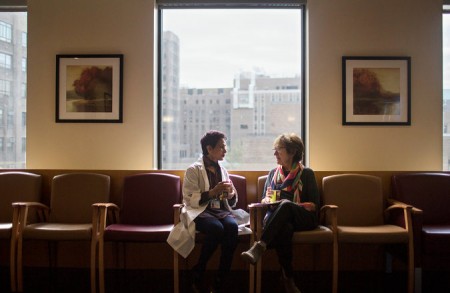 Dr. Azra Raza, left, speaking to Donna M., a patient who travels from Chicago for treatment for myelodysplastic syndromes, in a waiting room at NewYork-Presbyterian/Columbia. Credit Kirsten Luce for The New York Times
Dr. Azra Raza, left, speaking to Donna M., a patient who travels from Chicago for treatment for myelodysplastic syndromes, in a waiting room at NewYork-Presbyterian/Columbia. Credit Kirsten Luce for The New York Times
No other human disease is known to possess this degree of genetic heterogeneity. Adult-onset diabetes, for example, is a complex genetic disease, but it appears to be dominated by variations in only about a dozen genes. Cancer, by contrast, has potentially unlimited variations. Like faces, like fingerprints — like selves — every cancer is characterized by its distinctive marks: a set of individual scars stamped on an individual genome. The iconic illness of the 20th century seems to reflect our culture’s obsession with individuality.
If each individual cancer has an individual combination of gene mutations, perhaps this variability explains the extraordinary divergences in responses to treatment. Gene sequencing allows us to identify the genetic changes that are particular to a given cancer. We can use that information to guide cancer treatment — in effect, matching the treatment to an individual patient’s cancer.
Many of the remarkable successes of cancer treatments of the last decades are instances of drugs that were matched to the singular vulnerabilities of individual cancers. The drug Gleevec, for instance, can kill leukemia cells — but only if the patient’s cancer cells happen to carry a gene mutation called BCR-ABL. Tarceva, a targeted therapy for lung cancer, works powerfully if the patient’s cancer cells happen to possess a particular mutant form of a gene; for lung-cancer patients lacking that mutation, it may be no different from taking a placebo. Because the medicines target mutations or behaviors that are specific to cancer cells (but not normal cells), many of these drugs have surprisingly minimal toxicities — a far cry from combination chemotherapies of the past.
A few days after Donna’s visit to the clinic, I went to my weekly meeting with Raza on the ninth floor of the hospital. The patient that morning was K.C., a 79-year-old woman with blood cancer. Raza has been following her disease — and keeping her alive — for a decade.
“Her tumor is evolving into acute leukemia,” Raza said. This, too, is a distinctive behavior of some cancers that we can now witness using biopsies, CT scans and powerful new techniques like gene sequencing: We can see the cancers morphing from smoldering variants into more aggressive types before our eyes.
“Was the tumor sequenced?” I asked.
“Yes, there’s a sequence,” Raza said, as we leaned toward a screen to examine it. “P53, DNMT3a and Tet2,” she read from the list of mutant genes. “And a deletion in Chromosome 5.” In K.C.’s cancer, an entire segment of the genome had been lopped off and gone missing — one of the crudest mutations that a tumor can acquire.
“How about ATRA?” I asked. We had treated a few patients carrying some of K.C.’s mutations with this drug and noted a few striking responses.
“No. I’d rather try Revlimid, but at a higher dose. She’s responded to it in the past, and the mutations remain the same. I have a hunch that it might work.”
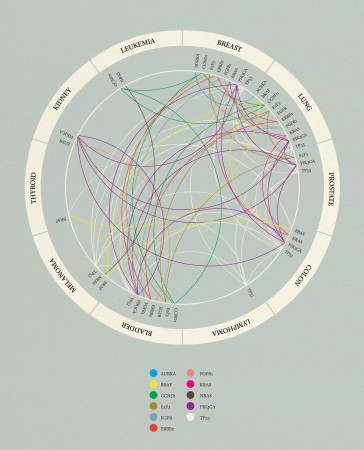
Cancer by Genes
Researchers have discovered that cancers they once assumed were quite different might be similar genetically, which means a treatment that used to work for only a small group of patients now might help a much larger group. Mutations in the gene E2F3, for example, are found in breast, lung, bladder and prostate cancers, among others. Knowing this, it’s possible to develop similar drugs that target the gene across different cancers.
As Raza and I returned to K.C.’s room to inform her of the plan, I couldn’t help thinking that this is what it had come down to: inklings, observations, instincts. Medicine based on premonitions. Chemo by hunch. The discussion might have sounded ad hoc to an outsider, but there was nothing cavalier about it. We parsed these possibilities with utmost seriousness. We studied sequences, considered past responses, a patient’s recent history — and then charged forward with our best guess. Our decisions were spurred by science, yes, but also a sense for the art of medicine.
Oncologists are also practicing this art in areas that rely less on genes and mutations. A week after Donna’s biopsy, I went to see Owen O’Connor, an oncologist who directs Columbia’s lymphoma center. O’Connor, in his 50s, reminds me of an amphibious all-terrain vehicle — capable of navigating across any ground. We sat in his office, with large, sunlit windows overlooking Rockefeller Plaza. For decades, he explained, oncologists had treated relapsed Hodgkin’s lymphoma in a standard manner. “There were limited options,” O’Connor said. “We gave some patients more chemotherapy, with higher doses and more toxic drugs, hoping for a response. For some, we tried to cure the disease using bone-marrow transplantation.” But the failure rate was high: About 30 percent of patients didn’t respond, and half of them died.
Then a year or two ago, he tried something new. He began to use immunological therapy to treat relapsed, refractory Hodgkin’s lymphoma. Immunological therapies come in various forms. There are antibodies: missile-like proteins, made by our own immune systems, that are designed to attack and destroy foreign microbes (antibodies can also be made artificially through genetic engineering, armed with toxins and used as “drugs” to kill cancer cells). And there are drugs that incite a patient’s own immune system to recognize and kill tumor cells, a mode of treatment that lay fallow for decades before being revived. O’Connor used both therapies and found that they worked in patients with Hodgkin’s disease. “We began to see spectacular responses,” he said.
Yet even though many men and women with relapsed Hodgkin’s lymphoma responded to immunological treatments, there were some who remained deeply resistant. “These patients were the hardest to treat,” O’Connor continued. “Their tumors seemed to be unique — a category of their own.”
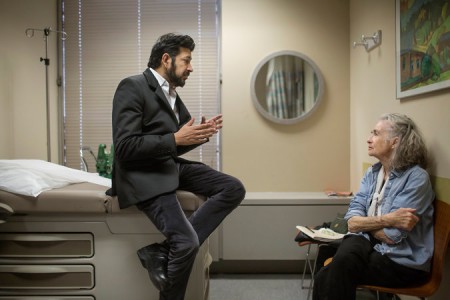 Dr. Siddhartha Mukherjee, left, speaking to K.C., who has acute myeloid leukemia, at NewYork-Presbyterian/Columbia. Credit Kirsten Luce for The New York Times
Dr. Siddhartha Mukherjee, left, speaking to K.C., who has acute myeloid leukemia, at NewYork-Presbyterian/Columbia. Credit Kirsten Luce for The New York Times
Lorenzo Falchi, a fellow training with O’Connor and me, was intrigued by these resistant patients. Falchi came to our hospital from Italy, where he specialized in treating leukemias and lymphomas; his particular skill, gleaned from his experience with thousands of patients, is to look for patterns behind seemingly random bits of data. Rooting about in Columbia’s medical databases, Falchi made an astonishing discovery: The men and women who responded most powerfully to the immune-boosting therapies had invariably been pretreated with another drug called azacitidine, rarely used in lymphoma patients. A 35-year-old woman from New York with relapsed lymphoma saw her bulky nodes melt away. She had received azacitidine as part of another trial before moving on to the immunotherapy. A man, with a similar stage of cancer, had not been pretreated. He had only a partial response, and his disease grew back shortly thereafter.
Falchi and O’Connor will use this small “training set” to begin a miniature trial of patients with relapsed Hodgkin’s disease. “We will try it on just two or three patients,” Falchi told me. “We’ll first use azacitidine — intentionally, this time — and then chase it with the immune activators. I suspect that we’ll reproduce the responses that we’ve seen in our retrospective studies.” In lung cancer too, doctors have noted that pretreating patients with azacitidine can make them more responsive to immunological therapy. Falchi and O’Connor are trying to figure out why patients respond if they are pretreated with a drug that seems, at face value, to have nothing to do with the immune system. Perhaps azacitidine makes the cancer cells more recognizably foreign, or perhaps it forces immune cells to become more aggressive hunters.
Falchi and O’Connor are mixing and matching unexpected combinations of medicines based on previous responses — departing from the known world of chemotherapy. Even with the new combination, Falchi suspects, there will be resistant patients, and so he will divide these into subsets, and root through their previous responses, to determine what might make these patients resistant — grinding the data into finer and finer grains until he’s down to individualized therapy for every variant of lymphoma.
Suppose every cancer is, indeed, unique, with its own permutation of genes and vulnerabilities — a sole, idiosyncratic “mind.” It’s obviously absurd to imagine that we’ll find an individual medicine to treat each one: There are 14 million new cases of cancer in the world every year, and several million of those patients will present with advanced disease, requiring more than local or surgical treatment. Trying to individualize treatment for those cases would shatter every ceiling of cost.
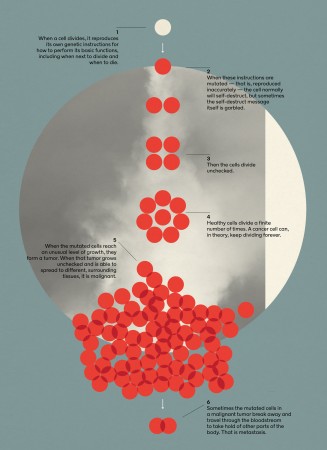 Cancer Development
Cancer Development
Cancer works the same way all life works, through the process of cell division and mutation. All living things grow and heal through cell division, and all living things evolve and change through the occasional mutations that occur as the cells divide. But some mutations can be deadly, leading to the unchecked growth that defines cancer. More than 14 million Americans have a history of cancer; it is expected to kill 600,000 Americans this year.
But while the medical costs of personalized therapy are being debated in national forums in Washington, the patients in my modest waiting room in New York are focused on its personal costs. Insurance will not pay for “off-label” uses of medicines: It isn’t easy to convince an insurance company that you intend to use Lipitor to treat a woman with pre-leukemia — not because she has high cholesterol but because the cancer cells depend on cholesterol metabolism for their growth (in one study of a leukemia subtype, the increasing cells were highly dependent on cholesterol, suggesting that high doses of Lipitor-like drugs might be an effective treatment).
In exceptional cases, doctors can requisition pharmaceutical companies to provide the medicines free — for “compassionate use,” to use the language of the pharma world — but this process is unpredictable and time-consuming. I used to fill out such requests once every few months. Now it seems I ask for such exceptions on a weekly basis. Some are approved. A majority, unfortunately, are denied.
So doctors like Falchi and O’Connor do what they can — using their wiles not just against cancer but against a system that can resist innovation. They create minuscule, original clinical trials involving just 10 or 20 patients, a far cry from the hundred-thousand-patient trials of the ’80s and ’90s. They study these patients with monastic concentration, drawing out a cosmos of precious data from just that small group. Occasionally, a patient may choose to pay for the drugs out of his or her own pockets — but it’s a rare patient who can afford the tens of thousands of dollars that the drugs cost.
But could there be some minimal number of treatments that could be deployed to treat a majority of these cancers effectively and less expensively? More than any other scientist, perhaps, Bert Vogelstein, a cancer geneticist at Johns Hopkins University, has tackled that conundrum. The combination of genetic mutations in any individual cancer is singular, Vogelstein acknowledges. But these genetic mutations can still act through common pathways. Targeting pathways, rather than individual genes, might reorganize the way we perceive and treat cancer.
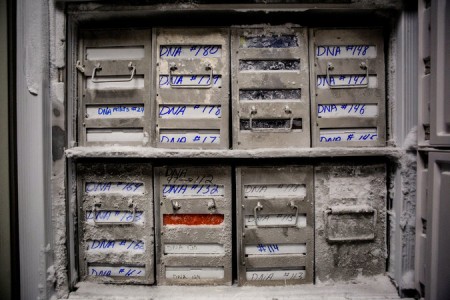 Deep freezers containing bone marrow, bone-marrow plasma and blood serum in Siddhartha Mukherjee’s research lab. Credit Kirsten Luce for The New York Times
Deep freezers containing bone marrow, bone-marrow plasma and blood serum in Siddhartha Mukherjee’s research lab. Credit Kirsten Luce for The New York Times
Imagine, again, the cell as a complex machine, with thousands of wheels, levers and pulleys organized into systems. The machine malfunctions in the cancer: Some set of levers and pulleys gets jammed or broken, resulting in a cell that continues to divide without control. If we focus on the individual parts that are jammed and snapped, the permutations are seemingly infinite: Every instance of a broken machine seems to have a distinct fingerprint of broken cogs. But if we focus, instead, on systems that malfunction, then the seeming diversity begins to collapse into patterns of unity. Ten components function, say, in an interconnected loop to keep the machine from tipping over on its side. Snap any part of this loop, and the end result is the same: a tipped-over machine. Another 20 components control the machine’s internal thermostat. Break any of these 20 components, and the system overheats. The number of components — 10 and 20 — are deceptive in their complexity, and can have endless permutations. But viewed from afar, only two systems in this machine are affected: stability and temperature.
Cancer, Vogelstein argues, is analogous. Most of the genes that are mutated in cancer also function in loops and circuits — pathways. Superficially, the permutations of genetic flaws might be boundless, but lumped into pathways, the complexity can be organized along the archetypal, core flaws. Perhaps these cancer pathways are like Hollywood movies; at first glance, there seems to be an infinite array of plot lines in an infinite array of settings — gold-rush California, the Upper West Side, a galaxy far, far away. But closer examination yields only a handful of archetypal narratives: boy meets girl, stranger comes to town, son searches for father.
How many such pathways, or systems, operate across a subtype of cancer? Looking at one cancer, pancreatic, and mapping the variations in mutated genes across hundreds of specimens, Vogelstein’s team proposed a staggeringly simple answer: 12. (One such “core pathway,” for instance, involves genes that enable cells to invade other tissues. These genes normally allow cells to migrate through parts of the body — but in cancer, migration becomes distorted into invasion.) If we could find medicines that could target these 12 core pathways, we might be able to attack most pancreatic cancers, despite their genetic diversity. But that means inventing 12 potential ways to block these core paths — an immense creative challenge for scientists, considering that they haven’t yet figured out how to target more than, at best, one or two.
Immunological therapies provide a second solution to the impasse of unlimited diversity. One advantage of deploying a patient’s own immune system against cancer is that immunological cells are generally agnostic to the mutations that cause a particular cancer’s growth. The immune system was designed to spot differences in the superficial features of a diseased or foreign cell, thereby identifying and killing it. It cares as little about genes as an intercontinental ballistic missile cares about the email addresses, or dietary preferences, of the population that it has been sent to destroy.
A few years ago, in writing a history of cancer, I interviewed Emil Freireich. Freireich, working with Emil Frei at the National Cancer Institute in the 1960s and ’70s, stumbled on the idea of deploying multiple toxic drugs simultaneously to treat cancer — combination chemotherapy. They devised one of the first standard protocols — vincristine, Adriamycin, methotrexate and prednisone, known as VAMP — to treat pediatric leukemias. Virtually nothing about the VAMP protocol was individualized (although doses could be reduced if needed). In fact, doctors were discouraged from trying alternatives to the formula.
Yet as Freireich recalled, long before they came up with the idea for a protocol, there were small, brave experiments; before trials, there was trial and error. VAMP was brought into existence through grit, instinct and inspired lunges into the unknown. Vincent T. DeVita Jr., who worked with Freireich in the 1960s, wrote a book, “The Death of Cancer,” with his daughter, Elizabeth DeVita-Raeburn. In it, he recalled a time when the leukemic children in Freireich’s trial were dying of bacterial meningitis during treatment. The deaths threatened the entire trial: If Freireich couldn’t keep the children alive during the therapy, there would be no possibility of remission. They had an antibiotic that could kill the microbe, but the medicine wouldn’t penetrate the blood-brain barrier. So Freireich decided to try something that pushed the bounds of standard practice. He ordered DeVita, his junior, to inject it directly into the spinal cords of his patients. It was an extreme example of off-label use of the drug: The medicine was not meant for use in the cord. DeVita writes:
“The first time Freireich told me to do it, I held up the vial and showed him the label, thinking that he’d possibly missed something. ‘It says right on there, “Do not use intrathecally,” ’ I said. Freireich glowered at me and pointed a long, bony finger in my face. ‘Do it!’ he barked. I did it, though I was terrified. But it worked every time.”
When I asked Freireich about that episode and about what he would change in the current landscape of cancer therapy, he pointed to its extreme cautiousness. “We would never have achieved anything in this atmosphere,” he said. The pioneer of protocols pined for a time before there were any protocols.
Medicine needs standards, of course, otherwise it can ramble into dangerous realms, compromising safety and reliability. But cancer medicine also needs a healthy dose of Freireich: the desire to read between the (guide)lines, to reimagine the outer boundaries, to perform the experiments that become the standards of the future. In January, President Obama introduced an enormous campaign for precision medicine. Cancer is its molten centerpiece: Using huge troves of data, including gene sequences of hundreds of thousands of specimens and experiments performed in laboratories nationwide, the project’s goal is to find individualized medicines for every patient’s cancer. But as we wait for that decades-long project to be completed, oncologists still have to treat patients now. To understand the minds of individual cancers, we are learning to mix and match these two kinds of learning — the standard and the idiosyncratic — in unusual and creative ways. It’s the kind of medicine that so many of us went to medical school to learn, the kind that we’d almost forgotten how to practice.
*This news story was resourced by the Oral Cancer Foundation, and vetted for appropriateness and accuracy.

Leave A Comment
You must be logged in to post a comment.